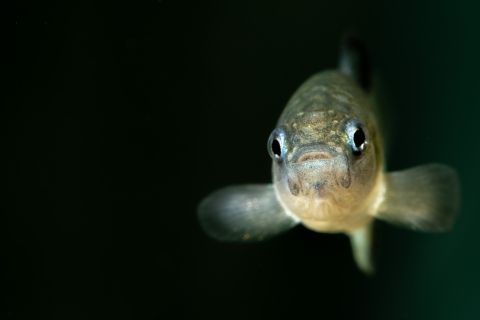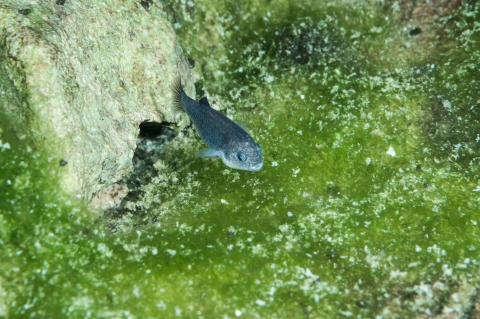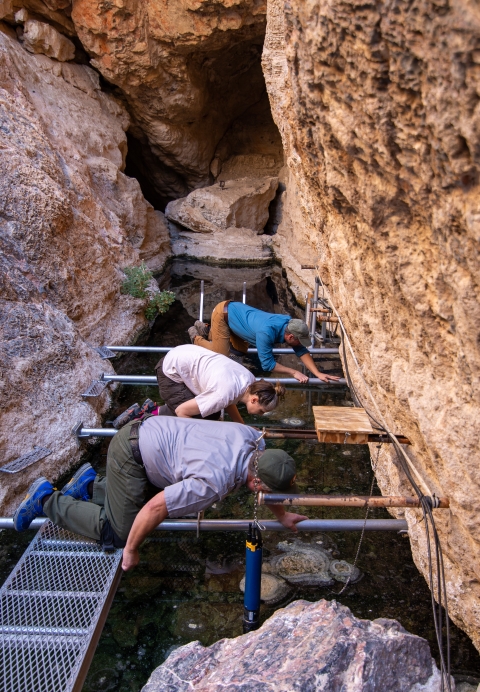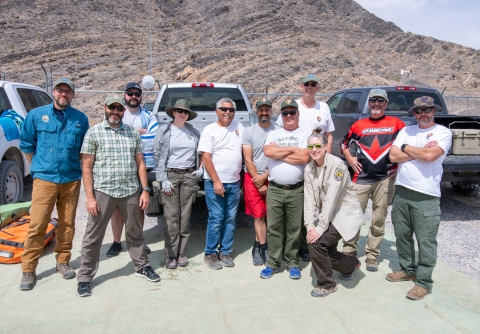For more than 50 years, the U.S. Fish and Wildlife Service, National Park Service, Nevada Department of Wildlife and their partners have used scuba and surface monitoring for Devils Hole pupfish and it appears conservation and recovery efforts are paying off.
This past April, scientists counted 175 pupfish – the most observed of this critically endangered species in a spring count in 22 years. Fall counts are typically higher due to greater food resources as a result of more sunlight throughout the summer months.
Supervisory fisheries biologist for the department, Brandon Senger scuba-counted the “surprising” number of young fish below the surface with other biologists noting that the fish appeared to be in “both remarkable condition and very active.”
Devils Hole pupfish (Cyprinodon diabolis) live in the upper 80 feet of a deep water-filled cavern and sun-lit shallow pool at the cavern’s entrance, making this the smallest range of any vertebrate species on the planet. Devils Hole is a detached unit of Death Valley National Park surrounded by the Ash Meadows National Wildlife Refuge in Nye County, Nevada.
“Devil Hole is still under the impacts of groundwater pumping in the 60s so I feel that we have a duty as a society that if we’ve impacted the habitat for this pupfish, then we should do something to try to save it,” said Kevin Wilson, aquatic ecologist for Death Valley National Park, who manages the resources of Devils Hole.
The importance of the pupfish is more than just biodiversity and the Supreme Court decision in 1976 to protect the species accordingly per senior Service fish biologist Michael Schwemm.
“The protections that this iconic fish has, and the decisions made to support it in light of human development in the region caused an increased awareness in general throughout the desert southwest to protect other species of desert fishes,” Schwemm said of the Supreme Court decision. “This created an awareness of water issues in the desert southwest and an inspiration to do more.
“It's just such a different species and it is remarkable that it has managed to survive. It lacks pelvic fins due to the extreme conditions such as low food resources and high temperature, adapting to habitat conditions which have evolved over time.”
Those conditions have been mirrored in a 100,000-gallon tank at the Ash Meadows Fish Conservation Facility. This captive population guards against extinction that is currently around 300 fish according to fish biologist and facility manager Jennifer Gumm.
Population size in the wild is estimated by counting fish throughout the habitat, with standard counting protocols. Scientists scuba dive to count fish in the cavern, starting at depths below 100 feet. Simultaneously, other scientists count fish on the shallow shelf at the waters’ surface. The final count includes both surface and underwater fish.
“It’s not the way that you would think of to count most species of fishes,” said Gumm. “The unique cave habitat of Devils Hole and the population being so small for so long - those different components contribute to this being the best way to get a population size estimate.”
Before the 1990s, the population was around 200 pupfish in the spring. However, pupfish numbers have been especially low during the last two decades, averaging only 90 fish. This spring count continues an overall increase during the past nine years from the all-time low of 35 fish in spring 2013.
A return to higher numbers of pupfish this time of year could signal important changes in the ecosystem. “Such shifts highlight the importance of maintaining long-term data as we work to find out what’s changed,” said Wilson.
After the second population crash in 2013, with the previous dire situation coming in 2006, Schwemm said something needed to be done.
“In 2017, the managing agencies met to discuss how to react more efficiently next time,” Schwemm said. “We knew this was something we’d need to deal with – be able to respond quickly, so we developed a strategic plan with baseline information in case anyone on the team ever left, so we wouldn’t have to reinvent the wheel and start from ground zero.” The agencies are now working collaboratively to implement the strategic plan and be proactive in management of the species.
“It was exciting to see this shift (both in collaboration and pupfish numbers), because it allows more opportunities to study and explore new management options.” The next pupfish count occurs next fall.
Other research questions include studying genomic work to understand the genetic variation in both the wild and captive populations. “There is a really high potential that this will transform what we know and how we manage the species,” said Gumm.
Scientists are also looking at the fish in captivity to understand impacts of the environmental variables including climate change climate change
Climate change includes both global warming driven by human-induced emissions of greenhouse gases and the resulting large-scale shifts in weather patterns. Though there have been previous periods of climatic change, since the mid-20th century humans have had an unprecedented impact on Earth's climate system and caused change on a global scale.
Learn more about climate change .
“Being able to understand how temperature influences development, growth rates and morphology is something else we are looking at,” said Gumm. “So having success in captive breeding and high fish numbers, both in the wild and in captivity is allowing us to do a lot more research, to understand the species and inform management and recovery.”
Finally, according to Gumm, they have recently started understanding more about the physiology (how the body functions) of the fish by looking at waterborne hormones – where scientists can get the hormone levels just from the water the fish are in as a tool for understanding reproduction, and stress.
All of this has come together as a result of a strong effort at collaboration between agencies and other partners per Gumm, Wilson and Schwemm.
“This isn’t just one agency that is working on the recovery and conservation of this critically endangered fish,” said Wilson. "This interagency effort shows that it’s better to play well together in the sandbox and check your egos at the door. We’re really working well together now as a group. The pupfish and the habitat are the important part and we as scientists and managers are just trying to do what is best for them. It takes a team.”
Gumm agreed. “We are likely seeing some of these positive trends in population size because of the coordinated efforts that we have between the National Park Service, U.S. Fish and Wildlife Service, Nevada Department of Fish and Wildlife as well as outside partners,” she said.
Thanks to the recent population increases in the wild and captivity scientists are hopeful as they look towards the next 50 years of Devils Hole pupfish conservation.









